Comments on the Prize Winners
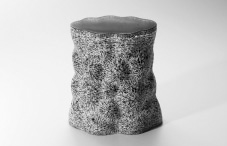 Takeda Today, the Grand Prize winner, the 10th Anniversary Special Prize winner and the Gold Prize winner are displayed in front of you. The rest of the winners will be introduced to you on the screen. On each winner, I’d like each juror to make some comments.
Takeda Today, the Grand Prize winner, the 10th Anniversary Special Prize winner and the Gold Prize winner are displayed in front of you. The rest of the winners will be introduced to you on the screen. On each winner, I’d like each juror to make some comments.
First, the Grand Prize winner by Lene Bodker, a female artist from Denmark, titled “SECTION”.
I’d like Mr. Myers to make comments on the work.
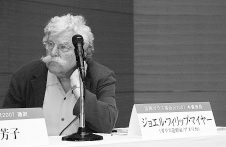 Myers Well you’ve heard the process by which we selected these pieces.
It’s very difficult for five people with five different experience and in this case four different countries to get together to decide important decisions about a work,
which for each artist is part of their life which extremely important and can be encouraging or discouraging for their career. However, I want to start out one thing to say, that anyone whose work was selected for this competition, whether they want a prize or not, should be very proud to be a part of the exhibition. Because this is my third jury, I felt that the
standard of work was much higher than that has been in the past. And that made me very happy because it means that people are paying more attention to what they submit to the juror. I think it a part of anyone’s best understanding of being professional. This understanding how to present yourself well is what you can promote.
Myers Well you’ve heard the process by which we selected these pieces.
It’s very difficult for five people with five different experience and in this case four different countries to get together to decide important decisions about a work,
which for each artist is part of their life which extremely important and can be encouraging or discouraging for their career. However, I want to start out one thing to say, that anyone whose work was selected for this competition, whether they want a prize or not, should be very proud to be a part of the exhibition. Because this is my third jury, I felt that the
standard of work was much higher than that has been in the past. And that made me very happy because it means that people are paying more attention to what they submit to the juror. I think it a part of anyone’s best understanding of being professional. This understanding how to present yourself well is what you can promote.
The Grand Prize was one, just one of three pieces that I was able to give 10 points to. So it’s obvious that there were two other pieces that I felt very strongly about as well. So when we tallied all of the points, I was forced to look at the final pieces that received 25 points, which in one case eliminated a piece I felt very strongly about. However, there was no doubt that’s the work I had to select for left me no doubt that the pieces were absolutely the best pieces to be judged to make a decision of.
So I felt very calm about that I support that piece very very strongly because as I sat here looked at the piece, I would like each of you to go up to feel it. I do not mean actually do it but that wonderful tact quality of this piece is a part of its appeal, a part of its character. When I look at the work, each piece I look at, I try to react in a way to understand what the idea of the piece was, that is to say, I look at a certain criteria, form, idea, execution, originality. These are at least four of the criteria not necessarily that order, which I tried to judge a work. I also would like to say that since we should all agree and I know that I am a very visual person that when I look at the exhibition and look at each piece, without a doubt, the pieces that related that I could relate to, the pieces that I could see evoke some emotional response in it.
Those were pieces that I more likely to sort out because they seem to fit my personality.
And I think this is one of the characteristically of different things about each of us jurors.
We are three artists and one critic and one curator. So each of us comes from different background and different counties. So I supported this piece because I loved the idea of the body and I love the idea of the form representing a natural form, the trunk of a tree. That’s why I love its relationship to nature because that’ s the kind of person I am in part of my life. That part of my life, the natural world has a profound effect on my body, my mind.
It would have been natural I think for people who know me to know that I will reach to that work because of that quality and the way in which that person worked the surface and almost as if wrapping your hands around the tree feeling the bark of the tree and feeling the life underneath it.
To me that’s why I greatly tried to convince the committee. That was the Grand Prize. Thank you for this.
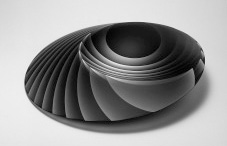 Takeda Thank you, Mr. Myers. Next, the 10th Anniversary Special Prize. Kojima’s work applied from Toyama is awarded. I’d like Mr. Harcuba to make comments on it.
Takeda Thank you, Mr. Myers. Next, the 10th Anniversary Special Prize. Kojima’s work applied from Toyama is awarded. I’d like Mr. Harcuba to make comments on it.
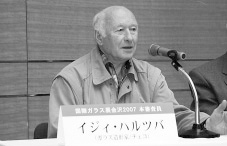 Harcuva All members of the jury agreed that the 10th Anniversary Special Prize of The International Exhibition of Glass Kanazawa should go to the sculpture made by Yukako Kojima. The reason to explain why is, I would say that the work represents engraving the Japanese traditional arts and crafts. The piece is executed perfectly.
Harcuva All members of the jury agreed that the 10th Anniversary Special Prize of The International Exhibition of Glass Kanazawa should go to the sculpture made by Yukako Kojima. The reason to explain why is, I would say that the work represents engraving the Japanese traditional arts and crafts. The piece is executed perfectly.
The second reason I think the most important is that the whole piece just represents the Japanese culture and history and the Japanese contemporary glass art.
To me the piece expresses a Haiku in it.
It’s specifically something about the Japanese landscape, about the moon, about the mist, about the mountains, the water, the clouds, just Japanese atmosphere.
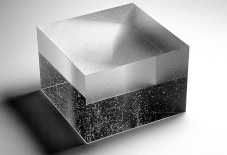 Takeda Thank you, Mr. Harucuba. Next, the Gold Prize winner by Pavel Trnka, teaching in Toyama as a visiting professor from the Czech Republic. I’d like Christensen to make comments on this work.
Takeda Thank you, Mr. Harucuba. Next, the Gold Prize winner by Pavel Trnka, teaching in Toyama as a visiting professor from the Czech Republic. I’d like Christensen to make comments on this work.
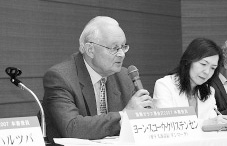 Christensen We see all the first four prizes, great simplicity in form that seems to be characteristic for a part of the glass art today. we have had long period where you have tried many different things, many wild things in the glass art. There is tendency in the moment where a part of glass art is going back to simple forms. In The Grand Prize winner where it was a simple form, but with a complicated work of the surface where the artists, so to say, hammered it as the sculptor hammers in stone. She had hammered out the structure the glass surface. In the Gold Prize work by Pavel Trnka who it was mentioned is a Czech artist who has worked for the last 3 years in Japan.
Christensen We see all the first four prizes, great simplicity in form that seems to be characteristic for a part of the glass art today. we have had long period where you have tried many different things, many wild things in the glass art. There is tendency in the moment where a part of glass art is going back to simple forms. In The Grand Prize winner where it was a simple form, but with a complicated work of the surface where the artists, so to say, hammered it as the sculptor hammers in stone. She had hammered out the structure the glass surface. In the Gold Prize work by Pavel Trnka who it was mentioned is a Czech artist who has worked for the last 3 years in Japan.
You have nearly the maximum of simplicity in form but the artist then worked out his ideas from inner of glass.
It’s a very characteristic thing of glass that you can, in most cases, look through it. You can have elements of the creation in the glass work coming out from the inside of the glass.
In this case it is an artist who is interested in South Asian and East Asian philosophy.
In the case here I can read and see it has Indian philosophy from the background of the Yoga thoughts which have been fundamental thoughts of the glass artist’s work.
I find it absolutely it’s one of the three maximum quality works in the exhibition or competition.
I’m very happy that we are able to give it the Gold Prize.
Takeda Thank you, Mr. Christensen. Next I’d like the jurors to make comments on the four Silver Prize winners.
First, I’d like Mr. Myers to make comments on the work by Midori Tsukada from Ishikawa. The jurors said that they wanted to give another Gold Prize to this work.
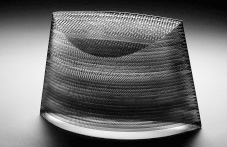 Myers This piece to me is a very very beautiful, rendered piece.
Myers This piece to me is a very very beautiful, rendered piece.
It is beautifully executed. The concept has to do with the complexity of interior form, the richness of that form in some ways it’s relationship to textile which is very very wonderful in Japan, wonderful history of that.
I see the alteration of the surface which creates distortion as the piece is moved in the three dimension which begins to create a different view of the piece, a different complexity, and another image. So the piece, in a sense, begins to take on another dimension. And it is a part of the idea which makes the piece exciting, not boring because it becomes something else as it uses light. And the degree of light also has something to say about what part of the piece you see and what part of it you don’t. So it really becomes a kind of mystery as well. So for me it is a marvelous piece in the style and in the quality of working with glass in a geometric way but also including a way of softening in a way that the artist has softened that geometry with color. And I see his piece, for example, almost as the three dimensional painting.
Takeda Thank you Next, I’d like Mr. Harucuba to make comments on the Silver Prize winner titled “THE BLACK” by a German artist.
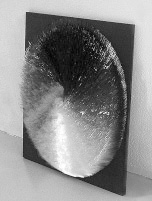 Harcuba She has worked out rather big wall installations in fine art galleries. She was awarded the Gold Prize in the major competition exhibition in Coburg, Germany one year ago. At that time she had three pieces of this. The effect is that from the distance it doesn’t look like glass at all. It looks like feathers and if you come very close, you can see the small parts of glass glued on the background. So this is something new, surprising. Because she got the prize in Germany, the jurors discussed whether or not it’s appropriate to give another prize to her work. However, this is one of the works which received the highest scorers, 25 points.
Harcuba She has worked out rather big wall installations in fine art galleries. She was awarded the Gold Prize in the major competition exhibition in Coburg, Germany one year ago. At that time she had three pieces of this. The effect is that from the distance it doesn’t look like glass at all. It looks like feathers and if you come very close, you can see the small parts of glass glued on the background. So this is something new, surprising. Because she got the prize in Germany, the jurors discussed whether or not it’s appropriate to give another prize to her work. However, this is one of the works which received the highest scorers, 25 points.
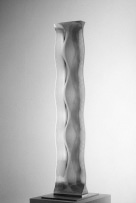 Takeda Thank you. Actually the size of this work is quite large, a square meter. The round center has gradation to the outskirts, which is made up of numerous thin, fragile glass pieces glued to the background.
In the distance, it looks as if feathers. It’s a unique work.
Next, I’d like Mr. Yokoyama to make comments on the Silver Prize winner by Iezumi from Kanazawa.
Takeda Thank you. Actually the size of this work is quite large, a square meter. The round center has gradation to the outskirts, which is made up of numerous thin, fragile glass pieces glued to the background.
In the distance, it looks as if feathers. It’s a unique work.
Next, I’d like Mr. Yokoyama to make comments on the Silver Prize winner by Iezumi from Kanazawa.
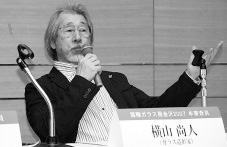 Yokoyama When I looked at this work by Iezumi, I felt that it’s an excellent work. I even thought that this work is being the Grand Prize winner. The technique of polishing the surface of the curved body is outstanding, which even makes me feel amazed. The diffused reflection is a little so much that the beautiful form cannot be fully admired. I hope that this particular problem will be solved soon.
Yokoyama When I looked at this work by Iezumi, I felt that it’s an excellent work. I even thought that this work is being the Grand Prize winner. The technique of polishing the surface of the curved body is outstanding, which even makes me feel amazed. The diffused reflection is a little so much that the beautiful form cannot be fully admired. I hope that this particular problem will be solved soon.
Takeda Thank you. I’d also like Mr. Yokoyama to make comments on the Silver Prize winner titled “Tsuzureori” by Takemoto from Toyama.
 Yokoyama This work makes me feel as if I looked at an abstract painting. It’s a good work. Although the color combination between black and yellow is a sort of dark, each time I look at the work, I feel that the work is beautiful. On the slide you cannot see the metal stand but the stand is a part of the work and its color, setting, and details are all sophisticatedly completed. I’m sure the artist has a very good aesthetic taste.
Yokoyama This work makes me feel as if I looked at an abstract painting. It’s a good work. Although the color combination between black and yellow is a sort of dark, each time I look at the work, I feel that the work is beautiful. On the slide you cannot see the metal stand but the stand is a part of the work and its color, setting, and details are all sophisticatedly completed. I’m sure the artist has a very good aesthetic taste.

